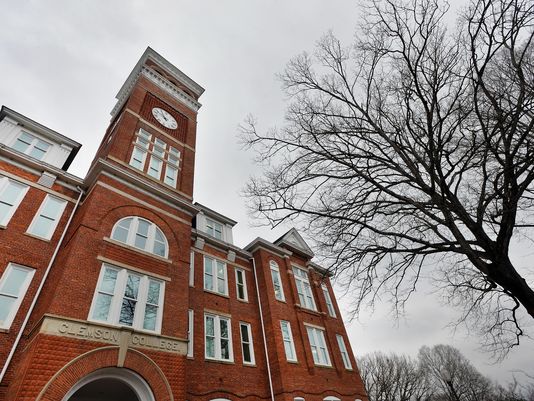Tillman Hall stands second only to the orange Tiger paw as the image most associated with Clemson University. Its image is displayed with framed diplomas in homes and offices around the world, splashed across TV screens on game days as the face of the university. Its red-brick clock tower rises above campus, a sight beloved by generations in the Clemson community.
But now, nearly a century after the death of Benjamin Ryan Tillman, Clemson is considering a proposal to rename Tillman Hall because of its namesake's racist past.
The Faculty Senate introduced and tabled a plan to rename Tillman on Tuesday.
On parallel paths, the faculty committee presenting the plan and a student-led movement both have called for Clemson's Board of Trustees to rename the building.
The student protesters' plan, which they read on the steps of Sikes Hall as part of a list of demands during a march and protest, calls for a response before the Board of Trustees next meeting Feb. 5-6.
Almeda Jacks, interim vice president for student affairs, told the protestors the university would respond by then.
What Clemson University must decide is not just whether Tillman, a founding father of the university and an unapologetic racist politician, is worthy of the honor, but also how it should recognize its history and maintain tradition while decrying the words and actions of the very men who created the school.
Many of those student protesters wore black T-shirts with orange letters that read "See the Stripes," referencing the school's Tiger mascot and the black stripes between the Clemson orange.
One long-time history professor, Alan Grubb, who is opposed to renaming Tillman, said he understands how Tillman's reputation is offensive, "but then again, Southern history is offensive to many people."
It wasn't named after Tillman to celebrate his racist or segregationist views, but for his contributions to the school, he said.
But Edith Dunlap, a black student who wants it renamed, called it a "slap in the face" every time she walks by Tillman, knowing who it's named for and what he did.
A.D. Carson, a graduate student whose poem and video, "See the Stripes," posted to YouTube in August was a call to action for many students, said the name makes some feel unwelcome in the Clemson family.
The problem is, those who speak of Tillman the place don't know about or choose not to acknowledge the dark side of Tillman the man, Carson said.
Torn between tradition and inclusion, Clemson's community will weigh its options. And as it does, one prominent voice has yet another idea, that the building should be named for a woman who perhaps had more to do with the school's founding than even Thomas Green Clemson.
Tillman: trustee, politician, racist
In 1890, Tillman watched as the cornerstone was set in place for the building on a slight hill on the Clemson campus that would one day bear his name.
He was important, one of seven original trustees critical to the university's founding, but his role was elevated above the others after his death, said Jerome Reel, Clemson University's historian.
He was born near Trenton in Edgefield County in 1847 and dropped out of school to join the Confederate Army in 1864. He contracted a serious illness and never fought in the war, his U.S. Congress biography says.
He was a leader of the Red Shirts white paramilitary group, involved in skirmish with a black militia group in July 1876 in the town of Hamburg. At least four black men were executed and two others, along with a white man, were killed.
Years later, Tillman boasted of the massacre in a speech in Anderson. "It was generally believed that nothing but bloodshed and a good deal of it" would teach the black militia a lesson, he said.
He said he was involved in four "race riots," advocated for a "lynch law" and openly vowed to protect white supremacy.
"We shot them. We stuffed ballot boxes, and did all that was necessary to maintain our hold on the government," he said about a viciously-contested 1876 gubernatorial election in a speech gathered in book form, titled the "Red Shirt Re-union at Anderson."
And so, Tillman's political career began.
He was a friend of Thomas Green Clemson, who in his will gave instructions to start a college on his estate and to appoint a board of trustees to oversee the school, Reel said.
Tillman was one of seven men listed in Clemson's will who were named lifetime trustees of the school, Reel said, one of the eight considered integral to the school's founding.
Tillman rose to political power through his virulent speeches that whipped up support for poor, white farmers. He was South Carolina governor from 1890-1894 when Clemson was founded and a U.S. Senator from 1894 until his death in 1918.
"So he played a critical role in the direction of revenues and resources towards the school," Reel said. "That doesn't make him any better than the other seven, but it does give you some idea of his magnitude."
But he was no more important than Thomas Green Clemson or Richard Wright Simpson, an attorney who penned Clemson's will and also became a trustee for life, Reel said.
Years after his death, Tillman's son, William, who was also a trustee, feared his father's contributions were being forgotten and pushed for a building to be named for his father, Reel said.
So in 1946, on the 50th anniversary of Clemson's first graduating class, the building called Main Building, or known as Old Main, was renamed Tillman Hall.
Honor or offense?
The rumblings for this latest conversation about cultural diversity on campus started in August with a six-minute video posted to YouTube.
The video features a poem written and read by Carson, a rhetoric communications and information design graduate student, to a musical score and images of historic and current Clemson.
It called for Clemson to recognize all of its history — the black slaves who tilled the land and picked the crops for their master, John C. Calhoun, whose plantation would one day become the site of a college where black convicts would lay the foundations, dig and fire the clay, and lay the bricks for Clemson's oldest buildings, including Tillman Hall.
It starts like this:
The site of "the most exciting 25 seconds in college football"
was made possible by profits from the most shameful centuries in America's history,
but come to the campus of Clemson University,
and you'd hardly be able to tell it from looking around.
The video garnered 7,500 views and launched a movement among some students who called for greater cultural inclusion on campus. The semester continued with events — and incidents — that built tension over how black students felt they were treated on campus.
The request to rename Tillman broke the discussion of race at Clemson into the open.
Grubb, the history professor, said he doesn't want Tillman Hall renamed because of the lessons it can teach today.
"If you start renaming everything that's old, then you start purging history of what has very valuable lessons," Grubb said. "If it's not named that anymore, then you really can't talk about this stuff."
It wasn't named after Tillman to celebrate his racist or segregationist views, but for his contributions to the school, he said.
Most people today associate Tillman Hall with place, not with the man himself, Grubb said.
"To me, the most telling thing is that the sign in front of Tillman Hall is devoted to Harvey Gantt and integration of the university," he said, referring to Clemson's first black student. "Tillman must be rolling over in his grave."
Abel Bartley, director of the Pan-African Studies program at Clemson, sees the debate from the other side. It's time for Clemson to rename Tillman, he said.
"I think that in order to be in step with the times we have to change with the times," Bartley said.
Minorities' opinions did not count when Tillman was named, and the university needs to be sensitive to the inclusive direction of the country today, he said.
"If you want to acknowledge the fact that he was the founder of Clemson, you can do that without making him the centerpiece of Clemson University," he said.
Dunlap, a junior English Writing and Publication Studies major, who has been involved in the student protests, said "seeing Tillman Hall every single day, knowing who it's named after, and knowing how he felt about black people is like a slap in the face."
State law's challenge
If the Faculty Senate recommends a name change, the faculty representative would present the request to the Clemson Board of Trustees, which would make a final decision.
But that, more than likely, would not be the end of the process.
Section 10-1-165, better known as The Heritage Act, made it possible to remove the Confederate Flag from the Statehouse in 2000.
Ironically, that law may make it more difficult to rename Tillman Hall or other buildings, statues, roads, memorials and schools that honor men whose views of the world do not mesh with modern society.
The law states that no structure on public property of the state that's "dedicated in memory of or named for any historic figure or historic event may be renamed or rededicated."
It applies to streets, bridges, parks, preserves, reserves or other public areas.
It would take a two-thirds vote by the General Assembly to make any provisions to the law, the act says.
Last year, two former Winthrop University students asked the Board of Trustees to rename its Tillman Hall. The board chair wrote a letter to the former students citing the difficulty of garnering enough support from the General Assembly to make an exception to rename Winthrop's Tillman Hall.
Clemson University's spokeswoman, Cathy Sams, said the university was aware of the state statute but didn't have a comment on it at this time.
The case for Clemson Hall
In the eyes of Clemson historian Reel, Tillman Hall is named for the wrong person.
In fact, Reel said the most recognizable building on Clemson's campus would be more aptly named Clemson Hall. But here's the twist — not after Thomas Green Clemson, whose will laid out the foundation for a college to exist on his estate — but after his wife, Anna Maria Clemson, the founding mother of the university.
The land upon which Clemson University was built came through Anna Maria's family. When she died in 1875, she willed the land to her husband with the intent to build an agricultural college.
After all, Reel points out, Clemson has become the alma mater for thousands of graduates. And alma mater is Latin for "nourishing mother."
There is no building or monument on campus to honor Anna Maria Clemson, though plans are in the works to add a monument near Tillman Hall.
As for Tillman, his name may more aptly be added to either Simpson Hall North or Simpson Hall South residence halls, named for Richard Wright Simpson.
"That would put it with all of the other will-life trustees" who have residence halls named after them, he said.
Whatever happens, Reel said the university students must understand that the Board of Trustees eventual decision would be made with the best long-term future of Clemson in mind.
"I wish everybody the best," he said. "I wish them to maintain their goodwill. The whole history of Clemson has been a history of high purpose where people have had to give in to each other to get it going."


